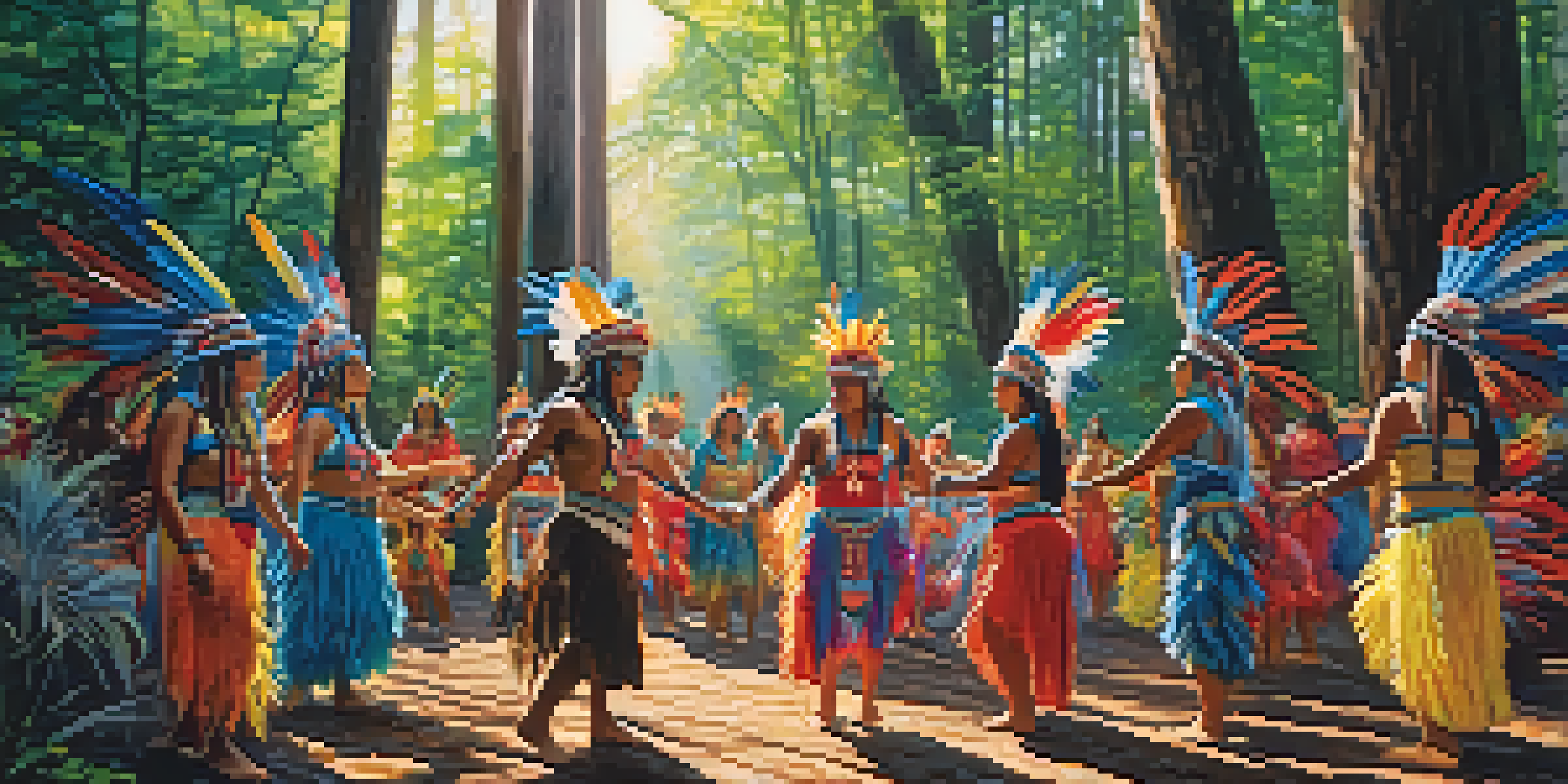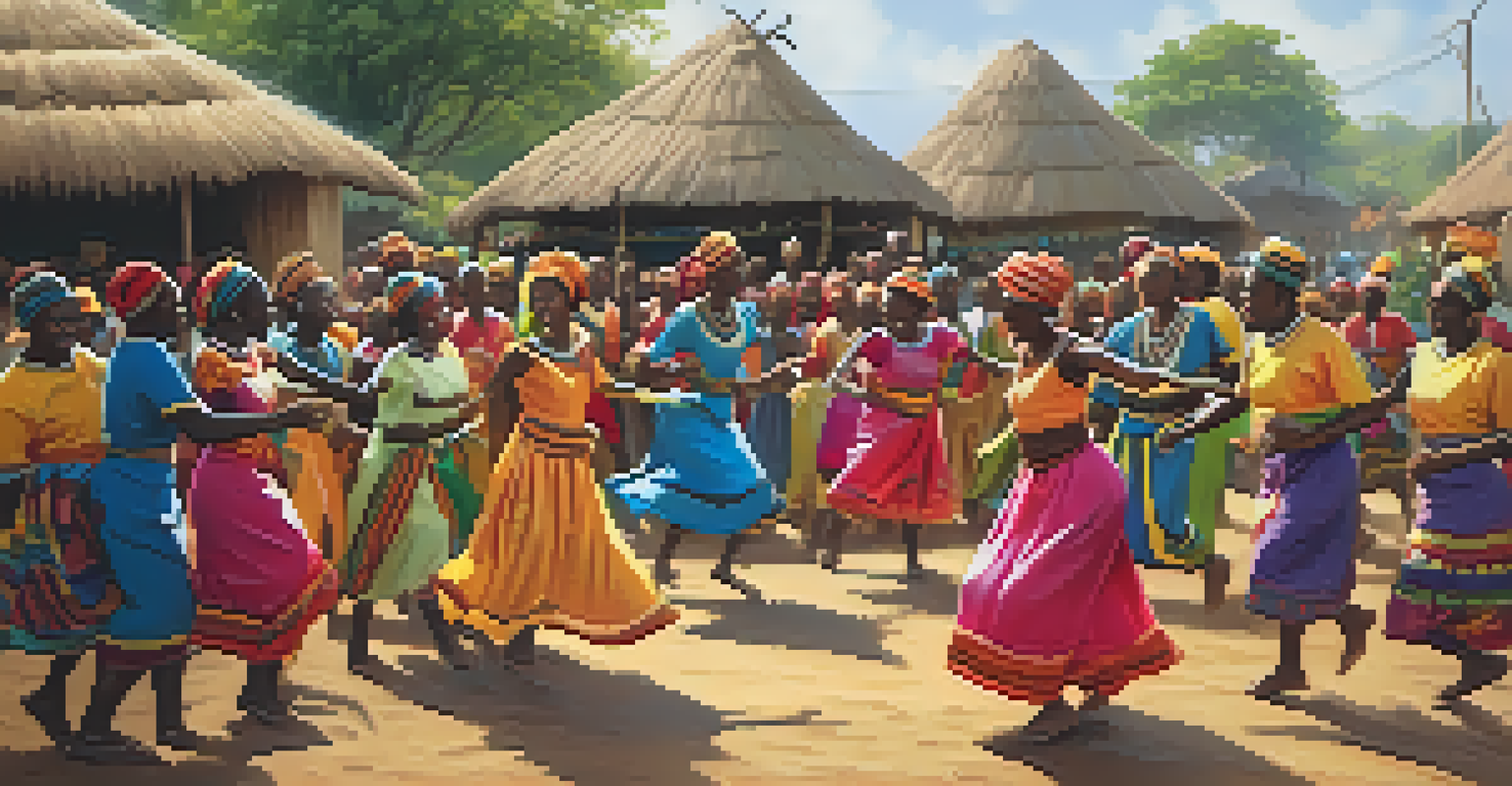Dance in Folklore: Symbolism and Cultural Narratives

Understanding Dance as a Cultural Expression
Dance has long been a potent form of cultural expression, transcending language and connecting people across generations. It serves as a canvas where stories, traditions, and values are vividly painted through movement. In many cultures, every dance tells a story, often rooted in historical events or myths, making it a living archive of community identity.
Dance is the hidden language of the soul.
For instance, the traditional dances of Native American tribes often symbolize their connection to nature and spirituality. Each movement carries meaning, from honoring ancestors to celebrating seasonal changes. This connection between dance and identity highlights how deeply intertwined these art forms are with the cultural narratives they embody.
Moreover, as communities evolve, their dances adapt, reflecting contemporary issues while still honoring tradition. This dynamic nature of dance allows for a unique blend of old and new, ensuring that cultural expressions remain relevant and resonant with future generations.
Symbolism in Dance: More Than Just Movement
At its core, dance often symbolizes much more than mere physical movement; it encapsulates emotions, beliefs, and social norms. Each gesture, rhythm, and pattern can convey complex ideas, such as love, struggle, or celebration. For example, the graceful movements of ballet can symbolize the struggle between freedom and restraint, showcasing the dancer's inner conflict.

In African dance, the symbolism is often tied to community and collective identity, where dances are performed to celebrate life events like births or marriages. The movements often mimic the actions of daily life, creating a bridge between the mundane and the sacred. This rich symbolism helps participants and audiences alike connect on a deeper level with the cultural narratives being told.
Dance as Cultural Storytelling
Dance serves as a vibrant canvas for cultural expression, telling stories and reflecting community identity through movement.
Furthermore, the costumes and music accompanying these dances add layers of meaning. Bright colors and intricate designs can signify different roles or statuses within the community, while the rhythm and beat enhance the emotional impact, making the dance a multi-sensory experience.
Folklore and Its Role in Shaping Dance Traditions
Folklore plays a crucial role in shaping dance traditions, serving as a repository of myths, legends, and historical events that inform dance practices. Many traditional dances are derived from folklore, reflecting the stories and values passed down through generations. This connection to folklore enriches the dance, providing context and depth that resonate with both performers and audiences.
To watch us dance is to hear our hearts speak.
For instance, the Irish jig is often linked to tales of fairies and mythical creatures, with its lively tempo embodying the joy and mischief found in those stories. As dancers perform, they not only entertain but also keep these age-old tales alive, weaving community identity into every step.
Additionally, the evolution of folklore can influence dance styles, leading to new forms that still honor their roots. This adaptability means that as societies change, their dances can evolve too, ensuring that cultural narratives remain relevant and reflective of contemporary experiences.
Rituals and Ceremonies: Dance as a Spiritual Connector
Dance often finds its most profound expression in rituals and ceremonies, acting as a bridge between the earthly and the spiritual. Many cultures incorporate dance into sacred practices, using movement to invoke blessings, celebrate life cycles, or honor deities. For instance, the Hula dance in Hawaiian culture is deeply spiritual, telling stories of creation and connection to the land through every graceful motion.
These ritualistic dances provide participants with a sense of belonging and purpose, as they engage with their spirituality through collective movement. The rhythmic patterns and communal aspects often create a transcendent experience, allowing individuals to feel part of something larger than themselves.
Symbolism and Emotion in Dance
Every gesture in dance conveys complex emotions and beliefs, enriching the connection between performers and audiences.
Furthermore, the symbolism inherent in these dances often reflects the values of the community, reinforcing shared beliefs and practices. This spiritual connection through dance not only preserves cultural heritage but also fosters unity and collective identity among participants.
Dance as a Reflection of Social Change
Dance is not static; it evolves alongside society, often reflecting social change and cultural shifts. As communities confront new challenges or embrace new ideas, their dances can mirror these transformations. For example, the emergence of hip-hop dance in urban environments speaks to the voices of youth culture and social justice, illustrating how dance can serve as a powerful tool for expression and resistance.
This responsiveness to social dynamics creates a dialogue between dance and society, where performers can comment on issues like inequality, identity, and community. Dances like the tango, which originated in the streets of Buenos Aires, also symbolize the blending of cultures and the social tensions of their time, showcasing how art can capture the essence of its era.
Moreover, as dance styles cross cultural boundaries, they often spark new movements that challenge traditional norms. This cross-pollination of ideas not only enriches the dance itself but also fosters a broader understanding and appreciation of diverse cultural narratives.
The Role of Storytelling in Dance
Storytelling is a fundamental aspect of dance, where each movement can narrate a tale or convey an emotion. Dancers become storytellers, using their bodies to express complex ideas that words may fail to capture. This narrative quality is evident in styles like contemporary dance, where performances often explore personal and societal themes through abstract movement.
In many folk traditions, such as the Russian ballet, storytelling is integral to the performance, with dancers embodying characters and bringing narratives to life. Audiences are transported into these stories, feeling the highs and lows through the expressive movements of the dancers. This emotional connection enhances the impact of the dance, making it a shared experience.
Preserving Traditions in Modern Times
In a globalized world, traditional dances evolve and adapt while still honoring their roots, ensuring cultural narratives are preserved for future generations.
Additionally, the fusion of music, costumes, and choreography further enriches the storytelling aspect. Together, these elements create a multisensory journey, allowing audiences to engage with the narrative on multiple levels, whether it's through the joy of celebration or the poignancy of loss.
Preserving Dance Traditions in a Globalized World
In our increasingly globalized world, the preservation of traditional dance forms becomes both a challenge and an opportunity. While cultural exchanges can dilute traditional practices, they also provide a platform for these dances to be shared and appreciated on a broader scale. For instance, the revival of traditional dances through festivals and workshops helps keep these art forms alive for future generations.
Communities are finding innovative ways to blend traditional and contemporary styles, creating hybrid forms that respect their roots while embracing modern influences. This evolution not only keeps the dance relevant but also allows it to be a living expression of cultural identity that resonates with younger audiences.

Moreover, the digital age offers new avenues for preservation, as performances can be recorded and shared online, reaching a global audience. This accessibility ensures that even as local practices evolve, the essence of these dances remains documented and celebrated, fostering a deeper appreciation for the rich cultural narratives they represent.